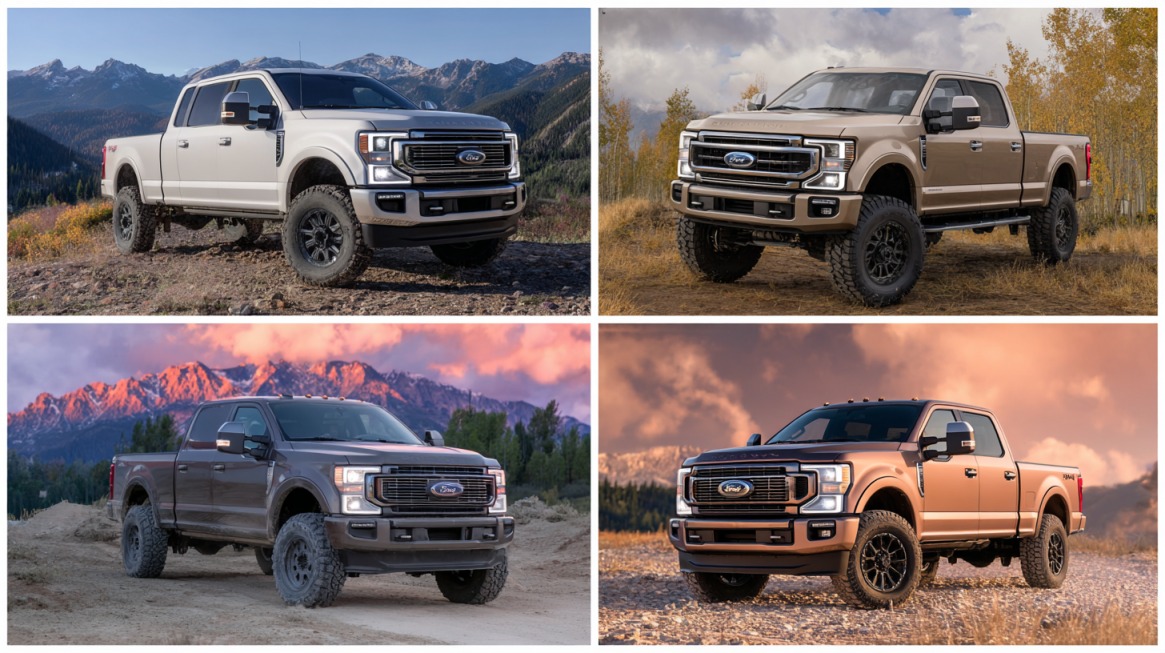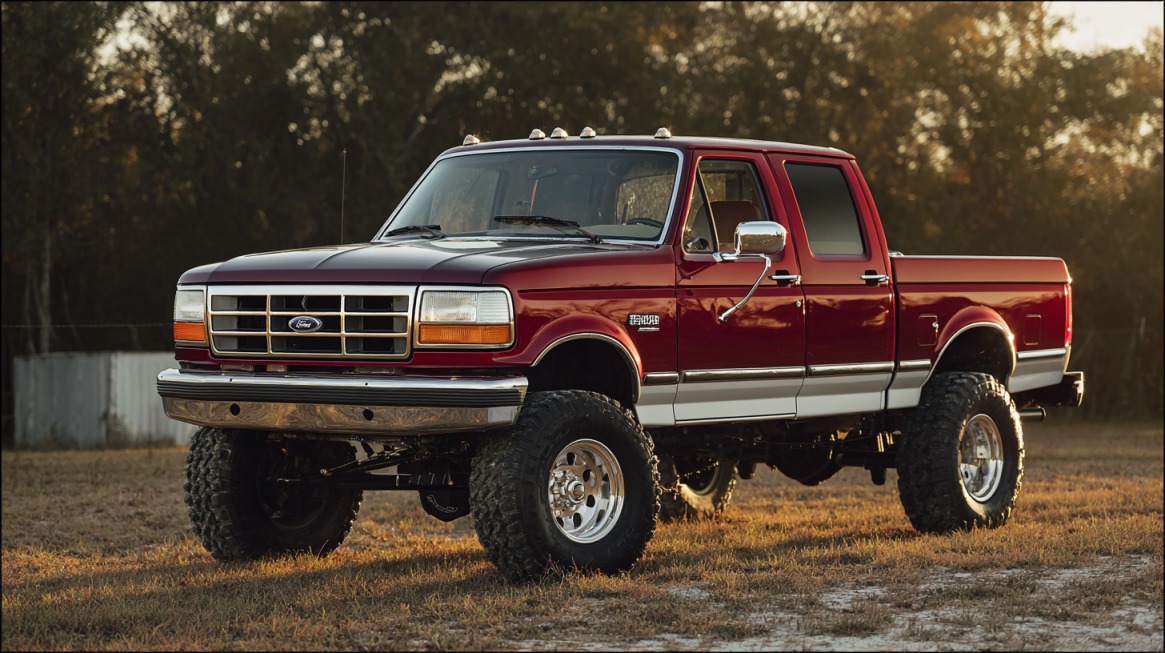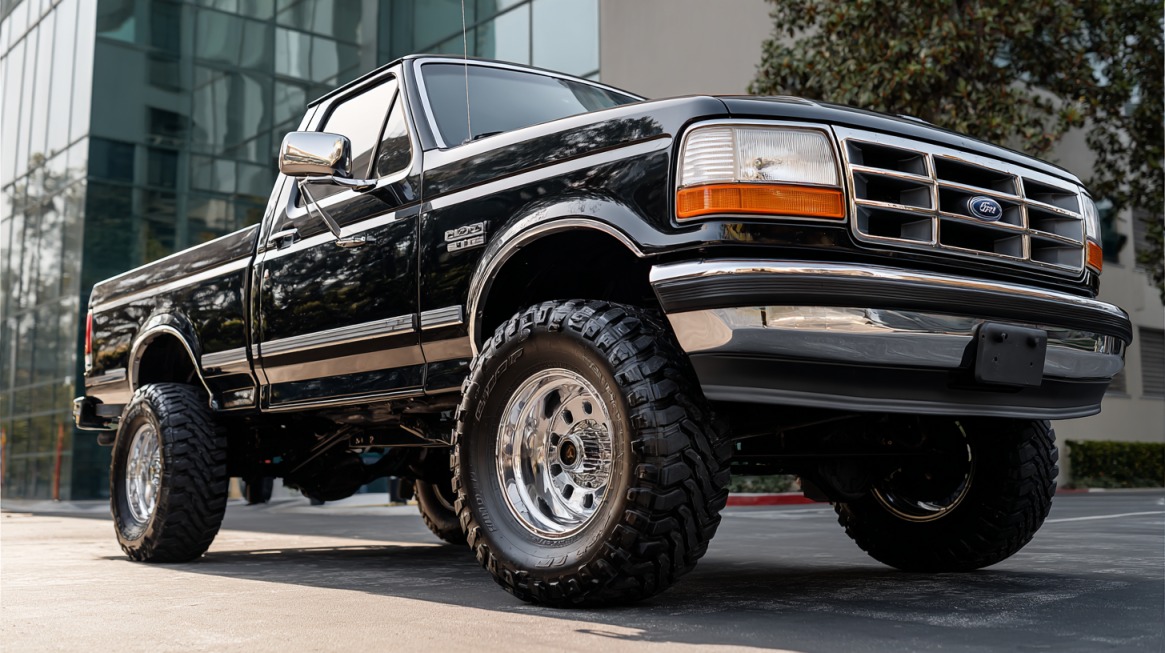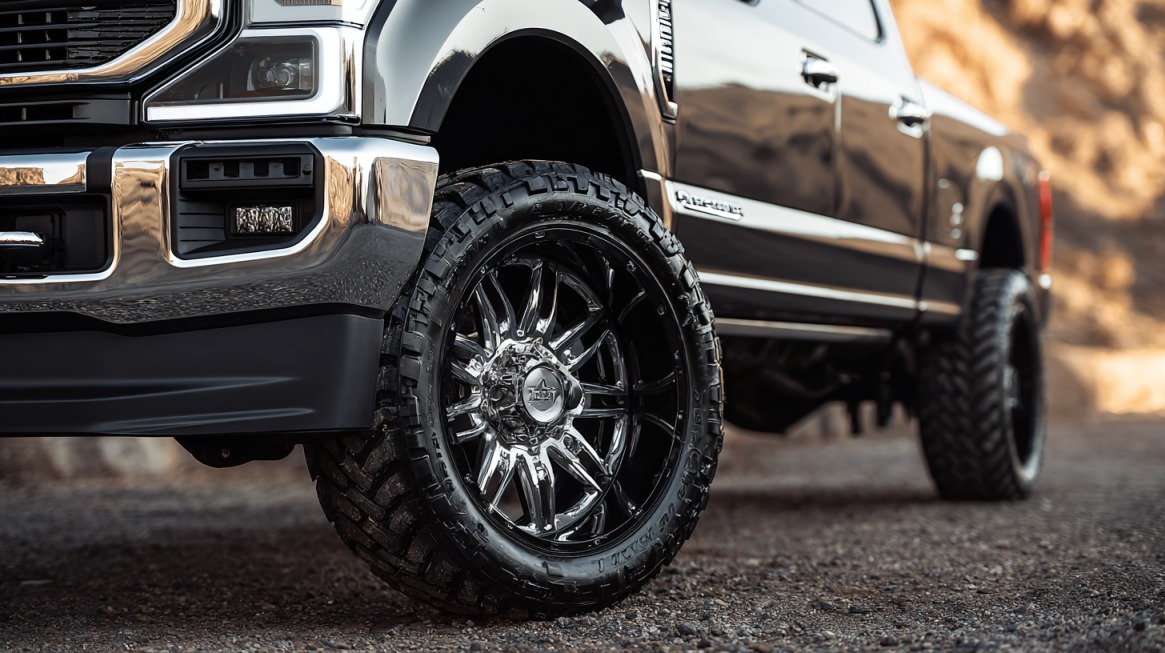Knowing basically all there is about bolt patterns is essential for anyone owning or maintaining a Ford F-250. Bolt configuration determines how the wheel mounts to the hub, directly affecting safety, handling, and performance. A mismatch can cause vibration, uneven wear, or even wheel detachment at high speeds.
F-250 trucks have evolved significantly through the years, adopting different lug patterns to accommodate mechanical improvements and changing design requirements.
- 8×6.5 inches (1961–1997)
- 8×170 millimeters (1999–present)
Recognizing these distinctions ensures proper wheel compatibility for upgrades, replacements, and performance tuning.
Ford F-250 Bolt Patterns by Generation (Year & Model Breakdown)
Proper wheel fitment depends heavily on identifying the correct bolt pattern for each generation of the Ford F-250.
Each redesign introduced new engineering standards, resulting in different lug patterns, hub bores, and thread sizes.
Recognizing these differences is crucial for maintenance, customization, or restoration.
Pre-Super Duty Models (1961–1997)
@jalopy_jeffTwin Turbocharged V10 Powered 1961 Ford Unibody Truck♬ original sound – Jalopy Jeff Sutton
Early generations of the Ford F-250 laid the foundation for its reputation as a durable workhorse.
Between 1961 and 1997, engineers equipped the truck with an 8×6.5-inch (8×165.1mm) bolt pattern that became a standard among heavy-duty pickups.
This configuration offered a balance between strength and accessibility, making replacement wheels easy to source even decades later.
- Lug Pattern: 8×6.5″ (8×165.1mm)
- Hub Bore: 124.9 mm
- Thread Size: 1/2″-20 or 9/16″-18 (depending on year)
- Offset Range: 0 to +20mm
- Common Wheel Sizes: 16–18”
- Typical Tire Sizes: 215/85R16 to 265/75R16
Wheel design during this period prioritized functionality and heavy-load support rather than appearance.
The wider hub bore contributed to better stability when towing or carrying construction materials.
In 1997, Ford introduced a transitional model known as the F-250 “Light Duty.” It marked a shift toward the upcoming Super Duty lineup but featured a completely different configuration that proved incompatible with both older and newer versions.
- Lug Pattern: 7×150mm
- Hub Bore: 87.1mm
- Thread Size: M14×2.0
- Compatibility Note: Not interchangeable with any other F-250 generation.
That single production year created confusion for many owners attempting wheel swaps, as it shared more characteristics with early F-150 designs than traditional F-250 builds.
Super Duty Era (1999–Present)

The launch of the Super Duty series in 1999 brought massive structural and mechanical upgrades.
Larger brakes, reinforced axles, and stronger suspension systems required a new lug design to handle higher torque and weight capacity.
Engineers switched to a metric pattern, signaling a major modernization in Ford’s heavy-duty lineup.
Below is a breakdown by generation:
1999–2007 (Super Duty I)
The first Super Duty generation adopted an 8×170mm bolt pattern with a 124.9mm hub bore.
Thread size increased to M14×2.0, enhancing strength and preventing wheel slippage under load. Offsets typically ranged between +40 and +50mm, balancing stability and clearance for towing and off-road work.
2008–2010 (Super Duty II)
Although still using the 8×170mm bolt pattern, the thread design evolved to M14×1.5. This adjustment provided smoother torque transfer and longer thread life under stress.
Offset measurements remained consistent with the earlier generation, maintaining compatibility for most OEM and aftermarket wheels.
2011–2016 (Super Duty III)
Retaining the same 8×170mm pattern, this generation standardized torque specifications at 224 Nm.
This adjustment improved safety by ensuring consistent pressure across all wheel lugs, reducing the likelihood of loosening during prolonged use.
2017–2020 (Super Duty IV)
Focus shifted toward variety and customization. While maintaining the 8×170mm design, wheel and tire options expanded to accommodate both performance and comfort.
- LT275/65R18
- LT275/70R18
- LT275/65R20
Higher load capacities made these trucks suitable for towing, while new wheel options enhanced aesthetic flexibility.
@hausplans Thinking to upgrade to a new Super Duty F250 #build #howto #truck #construction #diy #contractor ♬ original sound – Haus Plans ®️
2020–2022 (Super Duty IV Facelift)
The facelift phase retained the same bolt pattern but introduced refined wheel offsets and tire choices.
Improvements aimed to support upgraded suspension systems and increased towing power, giving owners broader customization opportunities.
2023–2025 (Super Duty V)
Modern F-250s continue using the reliable 8×170mm standard but emphasize visual appeal and high performance.
A growing number of owners now prefer 22-inch wheels paired with aggressive all-terrain tires, complementing lifted builds and off-road applications.
Manufacturers have also begun designing aftermarket wheels to fit more precisely, supporting enhanced handling for both highway and rugged terrain use.
Lug Nut Sizes by Generation

- 1/2″–20 UNF: Used throughout the 1970s and early 1980s.
- 9/16″–18 UNF: Adopted in late 1980s through the 1990s for improved clamping strength.
- M14×2.0: Introduced in 1999 with the first Super Duty generation.
- M14×1.5: Applied from 2008 onward for modern Super Duty models, offering better torque consistency.
Each change reflected Ford’s focus on balancing wheel security, torque control, and compatibility with evolving brake systems.
Wheel Fitment Essentials
Proper wheel fitment depends on several interrelated factors, not just the bolt pattern itself. Each parameter influences driving feel, stability, and long-term wear. Before installing new wheels, every owner should evaluate:
Offset and Backspacing: Offset determines how far a wheel sits in relation to the fender. A positive offset tucks wheels inward, while a negative offset pushes them outward, ideal for aggressive or lifted setups.
- Hub Bore Fit: F-250 models commonly use a 124.9mm hub bore, designed for hub-centric wheels that reduce vibration and ensure even weight distribution.
- Centering Method: Hub-centric fits are preferred for stability, while lug-centric setups rely solely on lug pressure, which may increase stress on the hardware.
- Thread Pitch and Torque Specs: Correct torque ensures proper seating. For Super Duty trucks, following factory specifications such as 224 Nm prevents warping or loosening.
- Adapters and Spacers: Using spacers can help match older wheels, but they must be precisely engineered and installed to maintain alignment and prevent mechanical failure.

Attention to these details guarantees compatibility between wheel, hub, and suspension, preserving both performance and safety.
Aftermarket & OEM Wheel Options
Wheel selection influences both the performance and appearance of an F-250. Owners often choose between OEM and aftermarket solutions depending on how they use the truck.
- Balanced handling under heavy loads.
- Proper offset and hub alignment.
- Long-term durability and corrosion resistance.
Aftermarket wheels offer expanded design freedom and tailored performance. Popular brands among F-250 owners include:
- Fuel Off-Road – known for rugged off-road applications.
- XD Series – favored for aggressive looks and strength.
- American Racing – offers classic and modern styles.
- Moto Metal – designed for lifted trucks and large tires.
- Pro Comp – suitable for off-road enthusiasts seeking high load capacity.
When upgrading, verifying bolt pattern, hub size, and offset alignment ensures the truck’s suspension geometry remains intact. Proper fitment prevents rubbing, maintains ride quality, and optimizes braking response.
Common Upgrade Scenarios

Wheel upgrades are often motivated by function, appearance, or both. Each purpose calls for a specific setup to ensure optimal results.
- Off-Road Builds: Often use 35-inch or 37-inch tires combined with lift kits and high-offset wheels. This enhances traction, clearance, and performance over uneven terrain.
- Towing Applications: Require reinforced alloy or steel wheels rated for high loads. Ensuring proper torque helps prevent wheel flex and vibration during extended towing.
- Daily Drivers: Benefit most from lightweight aluminum alloys that improve fuel economy, acceleration, and steering precision.
- Vintage Restorations: Restorers prioritize period-correct designs that match the look of older F-250s. Adapters or custom hubs may be necessary to mount wheels on older 8×6.5-inch setups.
Careful assessment of offset, bolt compatibility, and weight capacity ensures every upgrade enhances both function and longevity.
Regular torque checks and professional balancing complete the process, preserving the truck’s performance integrity.
Summary
Proper wheel fitment ensures that a Ford F-250 performs safely and efficiently under all conditions. Every generation introduced refinements to bolt patterns, lug sizes, and offsets to meet evolving demands for towing, hauling, and durability.
Verifying specifications before any purchase or modification prevents mechanical failure and costly mistakes. A well-matched set of wheels not only complements the truck’s capabilities but also guarantees performance consistency and driving confidence.
